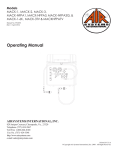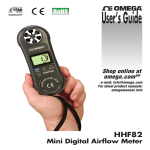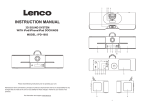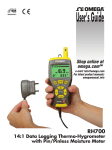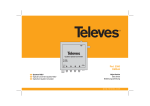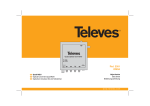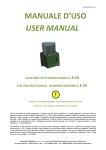Download WDR - MICRO-AIDE
Transcript
WDR W HISTLE D ETECTOR R ELAY U SER M ANUAL M ICRO -A IDE R AIL S IGNAL P RODUCTS E VENT R ECORDERS S PEED M ONITORS C URRENT S ENSORS I SOLATED M ODEMS B ATTERY M ONITORS V OLTAGE M ONITORS L IGHT O UT D ETECTORS C LOCK S YNCHRONIZERS W HISTLE D ETECTORS L OCAL C ONTROL P ANELS C USTOM E NGINEERING MICRO-AIDE CORPORATION Tel: 626-915-5502 Fax: 626-331-9484 685 Arrow Grand Circle Covina, CA 91722 E-mail: [email protected] WDR W HISTLE D ETECTOR R ELAY U SER M ANUAL The WDR can be used to avoid potential hazards at crossings during lengthy train delays. A whistle blast by the engineer is detected by the WDR and used to reactivate the nearby crossing lights and gate. Description Installation This document is intended to provide a detailed description of the use and operation of the MICRO-AIDE WDR Whistle Detector Relay. The WDR can be mounted on a shelf or back board. It may be oriented either horizontally or vertically. Four mounting holes at the base of the unit can be used to secure the WDR. The WDR is a unique audio device that allows a train engineer to activate a nearby crossing from a position within the train’s cab. A loud blast from the train’s whistle is automatically detected by the WDR. If the audio level and duration are sufficient the WDR will operate its internal relay. The relay includes two sets of contacts. Typically one set of contacts is wired to the control circuits of the crossing equipment. A detachable connector is used to simplify the wiring procedure. Wire gauges from 12 to 22 AWG may be used. Each conductor is secured by tightening the set screw associated with each connector terminal. The unit’s silkscreening provides a clear indication of the connections to be made. The power source is connected to the terminals labeled “B” and “N”. Dual power terminals are provided. The design of the WDR is fully compatible with a switched on/off power source. Consequently, the user may wish to connect the WDR to the power source through the normally open contacts of a relay. If the relay closes its contacts only when a train is present the WDR will be prevented from activating the crossing when a train is not at the station. This method of installation is strictly optional. If properly adjusted, the WDR will not falsely activate the crossing. However, this installation option will provide an additional measure of fail safe operation. The most common application requiring a WDR involves commuter trains stopped at a station. A lengthy delay of the train at the station may cause a nearby crossing to revert to its idle position (i.e., arms up, lights off). This may result in a potentially unsafe situation when the train is prepared to pull away from the station. However, proper use of the WDR can insure that the crossing will be activated prior to the train’s departure. The WDR is designed to be used in typical railroad environments. Its operating temperature range is -40°C to +72°C. Its rugged aluminum chassis and circuit board construction allow it to withstand harsh environmental conditions. The WDR’s internal printed circuit board includes a conformal coating. Its small footprint (4.2" by 4.7") allows it to be mounted in any convenient location. The wire pair from the external speaker or microphone should be connected to the terminals labeled “Mic.”. The WDR can be used with any 8 Ohm outdoor speaker or microphone. MICRO-AIDE does not supply a speaker or microphone with the WDR. The wires to the speaker should be twisted and kept to less than 100 ft. in length. It is best not to run the speaker wires alongside any power or high induction cables. The WDR can be powered by any source in the range from 8 to 36 Vdc. Its current draw is than 70 mA. Figure 1 provides a three-sided view of the WDR. The last page of this document lists detailed specifications. 2 Operation of the WDR is fully automatic once the sensitivity level and delay time are selected. No further adjustments or servicing is required. The WDR includes a pair of normally open, normally closed and common relay contacts. The contacts are labeled “N.O.”, “N.C.” and “Com.”, respectively. Both sets of contacts operate simultaneously. The crossing control circuit should be wired to one set of contacts. As an option, the spare set of contacts can be used to control an external lamp, or wired to a data logging device such as a MICRO-AIDE CWR-22xt Event Recorder. Maintenance and Trouble-shooting The WDR is designed to be completely maintenance free. It contains no consumable materials or serviceable components. There are no fuses or other replaceable parts internal to the unit. Setup and Operation The WDR provides adjustable control of its audio sensitivity and detection time settings. The two adjustment controls are labeled “Level Adj.” and “Delay Adj.”, respectively. Additionally, inside the WDR is a jumper setting that selects either high gain or low gain. The jumper setting is labeled “JP1”. If the jumper clip is off (default factory setting), the high gain setting is selected. If the jumper clip is on, the low gain setting is selected. The high gain setting adds 6 dB of gain relative to the low setting. The WDR is not prone to drift or stability problems. Consequently, it will not require periodic adjustments after its initial setup. However, the external speaker or microphone may over time lose some efficiency. For this reason, MICRO-AIDE recommends that the operation of each WDR installation be inspected at least once a year. All rail signal products manufactured by MICRO-AIDE are protected by a five-year limited warranty. Telephone numbers and a shipping address are listed below. The WDR can be properly adjusted by using the following procedure. Apply power to the WDR. The green “Power” LED should be illuminated. While the train whistle can be heard adjust the “Level Adj.” potentiometer until the “Sound” LED illuminates consistently. The “Sound” LED should turn off immediately after the whistle stops. Rotate the “Delay Adj.” potentiometer for the desired detection time. The detection time is measured from the start of the whistle blast to the time the “Relay” LED illuminates. The detection time can be adjusted in the range from approximately .5 to 10 seconds. MICRO-AIDE CORPORATION 685 Arrow Grand Circle Covina, CA 91722 Tel: 626-915-5502 Fax: 626-331-9484 E-mail: [email protected] 3 Figure 1 – Three-sided view 4 4.25" WDR Relay Delay Adj. Sound Level Adj. 4.2" Mic. Power B B N N 2.0" M ICRO -A IDE N.O. N.C. Com. Relay N.O. N.C. Com. 1.4" Detachable Connector Pot. Adjustments (2) LED Indicators (3) 3/16" Dia. Mounting Holes (4) 4.7" WDR W HISTLE D ETECTOR R ELAY S PECIFICATIONS Physical Size Length: 4.7" Width: 4.2" Height: 1.4" Weight Less than 8 oz. Environmental Storage Temperature: -40°C to 85°C Humidity: 0% to 95%, noncondensing Operating Temperature: -40°C to 72°C Humidity: 0% to 95%, noncondensing Mounting Can be secured to any flat surface Cover includes mounting holes Construction Chassis Fully enclosed, anodized aluminum Electrical Components mounted on internal PCB Power Voltage 8 to 36 Vdc Current 70 mA maximum Isolation LED Indicators Relay Contacts Minimum 3000 Vdc to all other points MIC Inputs Minimum 1500 Vdc to all other points MIC Input Transformer coupled, designed for 8 Ohm source impedance Microphone or outdoor speaker can be used as the input source Audio Sensitivity Minimum 250 mVrms at MIC inputs, with maximum gain setting Frequency Range 60 to 1000 Hz Not frequency discriminatory Detection Time Adjustable from .5 to 10 seconds Connector Detachable, screw-down with 12 terminals, 12 to 22 AWG Terminals 1 & 2: B, battery positive Terminals 3 & 4: N, battery negative Terminals 5 & 6: microphone Terminals 7 & 10: normally open relay contact Terminals 8 & 11: normally closed relay contact Terminals 9 & 12: relay common 5 Power: green Sound: green Relay: green Controls External Potentiometer for adjusting audio level, single turn Potentiometer for adjusting detection time, single turn Internal Jumper for setting audio gain, 26 dB (low) or 32 dB (high) Output Relay Operation Operates when audio level and duration exceed their respective limit values Type Non-latching mechanical, dual SPDT contacts Contacts Rated Load: 1 A at 24 Vdc, .5 A at 125 Vac Minimum Load: 1 mA at 5 Vdc Maximum Operating Voltage: 60 Vdc, 125 Vac Maximum Switching Capacity: 62.5 VA, 30 W Service Life: 5 million mechanical (minimum), 1 million electrical (typical)






